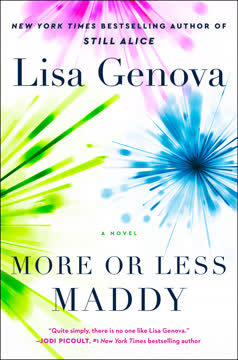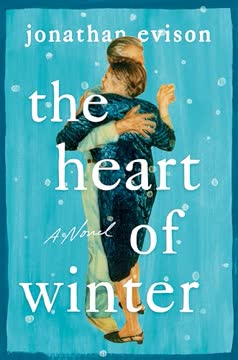Plot Summary
Ceiling Fans and Crashes
Maddy, a young woman in a Las Vegas hotel room, stares at a ceiling fan, contemplating suicide after a manic episode. She's exhausted, disoriented, and ashamed, unable to move or remember the details of the previous night. Her mind races with self-loathing and regret, recognizing the familiar descent into depression after a period of reckless, euphoric energy. The narrative introduces her as a comedian who's lost control, haunted by her family's warnings and her own inability to break the cycle of self-destruction. The chapter sets the tone for a story about mental illness, ambition, and the struggle for self-acceptance.
Homecoming and Old Patterns
Back in Connecticut after a tough first year at NYU, Maddy is exhausted and withdrawn, sleeping excessively and feeling detached from her family. Her mother's attempts to motivate her with food and job suggestions only highlight their disconnect. Maddy's relationships with her siblings, especially her high-achieving sister Emily, and her estranged father, are sketched out, revealing a family that prizes appearances and achievement. The pressure to conform and the sense of not fitting in are palpable, as is Maddy's growing sense of alienation.
Medical Forms and Masks
Maddy's annual physical becomes a performance, as she lies on intake forms to avoid scrutiny about her mental health. The depression survey triggers anxiety, but she masks her true feelings, even as her doctor dismisses her symptoms as normal "PMS." The experience is humiliating and alienating, reinforcing her reluctance to seek help or be honest about her struggles. The chapter underscores the stigma and misunderstanding surrounding mental illness, especially for young women.
Family Dinners, Family Roles
At a country club dinner, Maddy observes her family's rituals and the unspoken rules that govern their lives. Her mother's remarriage to Phil brought financial stability but emotional distance. Maddy feels out of place among her privileged, image-conscious relatives, longing for the warmth and authenticity of her childhood. The contrast between her mother's pursuit of normalcy and Maddy's sense of being an outsider is stark, highlighting the generational and personal divides that shape her identity.
Summer Job, Old Flames
Maddy finds solace in the routine of her Starbucks job and reconnects with her childhood friend Sofia. The return of her ex-boyfriend Adam, however, reignites old patterns of obsession and dependency. Their on-again, off-again relationship is a source of both comfort and pain, illustrating Maddy's vulnerability and her difficulty in setting boundaries. The chapter explores the ways in which technology and nostalgia can trap us in unhealthy cycles.
Sex, Secrets, and Control
Maddy's mother discovers evidence of her sexual activity, leading to a tense confrontation and a visit to a male gynecologist. The experience is invasive and patronizing, compounding Maddy's sense of powerlessness. Plans with friends are derailed by family obligations and Adam's manipulations, reinforcing the theme of Maddy's life being dictated by others' expectations and desires. The chapter delves into the intersection of sexuality, autonomy, and mental health.
Dorm Life, Sisterhood, and Isolation
Back at NYU, Maddy struggles to connect with her new roommate and classmates, feeling isolated despite being surrounded by people. Emily's visit offers a brief respite, but the gap between their lives is evident. Maddy's inability to form new friendships or find her place in the college environment exacerbates her depression, while her sister's effortless competence serves as a painful contrast.
Depression's Descent
Maddy's depression intensifies, making even basic self-care feel insurmountable. She skips classes, loses weight, and becomes fixated on self-harm as a means of coping with emotional pain. The act of cutting provides a fleeting sense of relief and control, but also deepens her shame and isolation. The chapter is a raw depiction of the physical and psychological toll of untreated mental illness.
Cutting, Drinking, and Academic Peril
As Maddy's academic performance plummets, she turns to alcohol and self-harm to numb her distress. A warning from the university about her grades triggers panic and suicidal ideation. She seeks help from the student health center, receiving a prescription for antidepressants and a temporary reprieve. The chapter highlights the precarious balance between survival and self-destruction, and the inadequacy of institutional responses to mental health crises.
Pills, Mania, and Comedy
The antidepressant initially lifts Maddy's mood, leading to a period of intense productivity and grandiosity. She becomes obsessed with Taylor Swift, convinced she's destined to write her biography and a Netflix comedy special. Her behavior becomes increasingly erratic and delusional, culminating in reckless spending and risky encounters. The chapter captures the seductive allure and destructive potential of mania, as well as the blurred line between creativity and illness.
Texts, Delusions, and Fallout
Maddy's manic episode spills into her digital life, as she bombards friends, family, and even Taylor Swift with a barrage of texts and DMs. Her family becomes alarmed by her incoherence and spending spree, leading to a confrontation at Thanksgiving. The chapter is a whirlwind of impulsivity, fractured relationships, and the unraveling of Maddy's sense of reality.
Thanksgiving Breakdown
During Thanksgiving dinner, Maddy's mania peaks in a chaotic scene involving a physical altercation, property damage, and threats with a knife. Her family, terrified and helpless, calls the police, resulting in Maddy's involuntary hospitalization. The episode is both tragic and darkly comic, illustrating the devastating impact of untreated bipolar disorder on individuals and families.
Hospital Restraints
Strapped to a hospital bed, Maddy is disoriented, angry, and convinced she's being wronged. She resists treatment and refuses to acknowledge her illness, clinging to her delusions and mistrust of authority. The chapter explores the trauma of psychiatric hospitalization and the difficulty of accepting help when one's sense of self is under siege.
Numbness and Recovery
Sedated and emotionally blunted by medication, Maddy drifts through her days in the hospital, unable to connect with her family or herself. The passage of time is meaningless, and her memories are fragmented. The chapter conveys the numbing effects of psychiatric drugs and the slow, uncertain process of recovery.
Diagnosis and Denial
In a meeting with her psychiatrist and mother, Maddy is formally diagnosed with bipolar disorder. Her mother is in denial, searching for alternative explanations and blaming medication or external factors. Maddy herself is stunned and resistant, struggling to reconcile the diagnosis with her sense of identity. The chapter examines the stigma and confusion surrounding mental illness, and the challenge of accepting a lifelong condition.
Lithium, Loss, and Letting Go
Back home, Maddy grapples with the side effects of lithium—tremors, fatigue, weight gain—and the loss of her relationship with Adam. She feels unlovable and hopeless, haunted by the belief that her illness defines her. Attempts at self-harm continue, and her mother's efforts to protect her only deepen her sense of isolation. The chapter is a portrait of grief, shame, and the struggle to find meaning in suffering.
Breakups and Breakdown
Adam breaks up with Maddy, unable to handle her illness. Maddy's depression worsens, leading to renewed self-harm and a near-suicidal overdose. Her mother's vigilance and the removal of privacy (no bathroom door, constant monitoring) underscore the loss of autonomy and trust. The chapter is a harrowing depiction of the intersection between mental illness and the loss of love, agency, and hope.
New York, New Rules
With her sister's support and her psychiatrist's cautious approval, Maddy moves in with Emily in New York, under strict conditions: medication adherence, mood tracking, and no drugs or alcohol. She finds work at Starbucks and begins to rebuild her life, forming new routines and friendships. The chapter explores the possibility of stability and the importance of support systems in recovery.
Comedy, Secrets, and Siblings
Maddy secretly returns to stand-up comedy, finding purpose and joy in writing and performing. She hides this from her mother and psychiatrist, fearing they'll see it as a symptom of mania. When Emily discovers the truth, a confrontation ensues, but Emily ultimately supports Maddy's passion, recognizing its role in her healing. The chapter highlights the tension between risk and reward, and the necessity of trust in relationships.
Permission, Trust, and Relapse
Maddy negotiates for more autonomy, promising to use a mood app and allow her family to monitor her well-being. Despite initial progress, she stops taking her meds before Emily's bachelorette party, triggering another manic episode. The cycle of secrecy, relapse, and hospitalization repeats, illustrating the chronic, relapsing nature of bipolar disorder and the limits of external control.
Open Mics and New Friends
Maddy immerses herself in the comedy scene, finding mentorship in Max and friendship in Simone. She hones her craft through open mics, bringer shows, and relentless writing, experiencing both triumphs and humiliations. The camaraderie and competition of the comedy world provide both support and challenge, helping Maddy to define her identity beyond her illness.
First Set, First High
With Simone's encouragement, Maddy performs her first open mic, experiencing the intoxicating high of making people laugh. Even a single genuine laugh is enough to validate her efforts and fuel her ambition. The experience is both terrifying and exhilarating, marking a turning point in her journey toward self-acceptance and creative fulfillment.
Mentors, Lovers, and Betrayal
Maddy's relationship with Max becomes both a source of inspiration and heartbreak. When he chooses another comic for a tour, Maddy is devastated but quickly finds a new opportunity in a women's comedy festival. The episode underscores the importance of resilience, adaptability, and self-worth in the face of rejection and disappointment.
Bringer Show, Big Dreams
Maddy's first bringer show is a triumph, and she's offered a spot as an opener on a college tour. The prospect of touring with Max is thrilling, but also fraught with anxiety about her readiness and the sustainability of her mental health. The chapter explores the tension between ambition and vulnerability, and the need for self-care in the pursuit of dreams.
Discovery, Confrontation, Bargain
Emily uncovers Maddy's secret comedy life, leading to a confrontation that threatens Maddy's fragile stability. Through negotiation and performance, Maddy earns her sister's trust and secures permission to continue pursuing comedy, provided she remains stable. The chapter highlights the importance of honesty, accountability, and the support of loved ones in managing mental illness.
Sister's Laughter, New Hope
Emily's genuine laughter at Maddy's set is a watershed moment, providing the validation and encouragement Maddy needs to continue. The sisters' bond is strengthened, and Maddy feels a renewed sense of hope and possibility. The chapter is a testament to the healing power of connection, humor, and acceptance.
Bachelorette, Mania, and Escape
At Emily's bachelorette party, Maddy's decision to stop her meds leads to a manic episode, culminating in a wild night of drinking, drugs, and impulsive decisions. She flees to Houston, convinced she's destined to open for Taylor Swift, only to be detained at the airport and hospitalized. The episode is a vivid illustration of the dangers of untreated mania and the thin line between fantasy and reality.
Vegas, Delusion, and Collapse
Maddy's mania continues in Las Vegas, where she believes she's collaborating with Taylor Swift and writing a hit album. The crash that follows is devastating, leading to another hospitalization and a painful reckoning with the consequences of her illness. The chapter explores the seductive power of delusion and the inevitable collapse that follows.
Aftermath, Acceptance, and Middle Path
In the aftermath of her latest episode, Maddy begins to accept her diagnosis and the need for ongoing treatment. She reflects on the cyclical nature of her illness, the importance of medication and support, and the challenge of finding a sustainable "middle path" between mania and depression. The chapter is a meditation on acceptance, resilience, and the possibility of living well with bipolar disorder.
Comedy's Door, Family's Love
Maddy's commitment to comedy deepens, even as her family struggles to understand and support her choices. Paid gigs, new material, and growing confidence mark her progress, while her mother's gradual acceptance signals a shift in their relationship. The chapter affirms the importance of purpose, creativity, and unconditional love in recovery.
Paid Gigs, Real Life
Maddy's first paid gigs are both a milestone and a reality check, as she navigates the challenges of financial instability, housing insecurity, and family conflict. The tension between her mother's desire for normalcy and Maddy's pursuit of comedy comes to a head, forcing difficult choices and new beginnings. The chapter is a portrait of adulthood, compromise, and the ongoing negotiation between safety and freedom.
Middle Path, Worthy Life
Maddy settles into a new rhythm, balancing medication, therapy, and comedy. She embraces her diagnosis as part of her story, but not its entirety, and finds meaning in connection, creativity, and self-acceptance. Tattoos, friendships, and family support mark her journey toward a "worthy" life, one that is neither normal nor broken, but uniquely her own.
Characters
Maddy Banks
Maddy is a young woman whose life is shaped by the highs and lows of bipolar disorder. A talented writer and aspiring comedian, she oscillates between periods of depression and mania, struggling to find stability and self-acceptance. Her relationships—with her family, friends, and lovers—are marked by both deep connection and painful rupture. Maddy's journey is one of self-discovery, resilience, and the ongoing negotiation between ambition and vulnerability. Her development is defined by her growing ability to accept her illness, advocate for herself, and find meaning in creativity and connection.
Emily Banks
Emily, Maddy's older sister, is the family's golden child—organized, successful, and nurturing. She acts as both sibling and surrogate parent, often mediating between Maddy and their mother. Emily's own life is marked by traditional milestones—marriage, career, motherhood—but she struggles to reconcile her love for Maddy with her fear for her safety. Emily's journey involves learning to trust Maddy's judgment, support her autonomy, and accept that stability may look different for each person.
Amy (Maddy's Mother)
Amy is a mother desperate to protect her daughter from harm, often resorting to control and surveillance in the name of safety. Her own history of trauma, particularly with Maddy's father, colors her responses to Maddy's illness. Amy's journey is one of gradual acceptance—learning to let go, trust, and support Maddy's choices, even when they diverge from her own ideals of normalcy and success.
Jack Banks
Maddy's brother Jack is the embodiment of unearned confidence and privilege. Athletic, popular, and largely unaffected by the family's turmoil, he offers occasional support and comic relief. Jack's role is to highlight the gendered and familial dynamics that shape Maddy's experience, and to provide a contrast to her struggles.
Sofia Logan
Sofia is Maddy's childhood best friend, whose relationship with Maddy is tested by distance, betrayal, and the challenges of adulthood. Despite periods of estrangement, Sofia remains a source of unconditional love and support, embodying the possibility of forgiveness and enduring friendship.
Max Perry
Max is a fellow comedian and Maddy's mentor-turned-lover. He offers guidance and validation, but ultimately prioritizes his own career and desires. Max's betrayal is a catalyst for Maddy's growth, forcing her to confront her own worth and the dangers of seeking validation from others.
Simone
Simone is a fellow barista and aspiring actor who becomes a key supporter of Maddy's comedy ambitions. Her encouragement and honesty help Maddy to take risks, embrace imperfection, and claim her identity as a comedian. Simone's presence represents the importance of chosen family and peer support.
Phil
Phil, Maddy's stepfather, provides financial security and a calm presence, but remains emotionally distant. His role is to support Amy and maintain the family's outward stability, while leaving the emotional labor to others. Phil's character highlights the limitations of material comfort in addressing deeper emotional needs.
Gramma
Maddy's grandmother is a source of unconditional love and hard-won wisdom. Having survived her own traumas, Gramma offers perspective, empathy, and hope. Her acceptance of Maddy's illness and her encouragement to fin
Last updated:
FAQ
Synopsis & Basic Details
What is More or Less Maddy about?
- A Journey of Self-Discovery: More or Less Maddy follows Maddy Banks, a young college student grappling with undiagnosed bipolar disorder, as she navigates the tumultuous highs of mania and the crushing lows of depression. The narrative charts her path from reckless impulsivity and self-harm to a hard-won acceptance of her diagnosis and a search for a stable, meaningful life.
- The Power of Creativity: At its core, the novel explores Maddy's unexpected discovery of stand-up comedy as both a creative outlet and a coping mechanism. Her journey into comedy, initially fueled by manic delusions, eventually becomes a genuine passion that helps her redefine her identity beyond her mental illness.
- Family and Acceptance: The story also delves into the complex dynamics of Maddy's family, particularly her relationships with her overprotective mother and supportive sister. It highlights their struggles to understand and accept Maddy's condition, ultimately showcasing how love, boundaries, and evolving perspectives are crucial for healing and connection.
Why should I read More or Less Maddy?
- Humanizing Mental Illness: Lisa Genova, a neuroscientist, offers a deeply empathetic and scientifically informed portrayal of bipolar disorder, demystifying its symptoms and challenging pervasive stigmas. Readers gain a raw, intimate understanding of what it feels like to live with this condition, fostering empathy and open conversation.
- A Story of Resilience and Hope: Despite the harrowing experiences of mania, depression, and hospitalization, Maddy's journey is ultimately one of profound resilience. The novel provides a hopeful message about finding purpose, self-acceptance, and a "worthy" life, even when faced with a chronic illness.
- Engaging Narrative and Unique Voice: Genova's writing style, characterized by Maddy's vivid internal monologues and a blend of humor and heartbreak, creates a compelling and authentic reading experience. The exploration of stand-up comedy as a path to self-expression adds a fresh and engaging layer to the mental health narrative.
What is the background of More or Less Maddy?
- Neuroscience Meets Fiction: Author Lisa Genova, a Harvard-trained neuroscientist, draws upon her expertise to craft a medically accurate yet deeply human story about bipolar disorder. Her background allows for a nuanced exploration of the biological and psychological complexities of the condition, grounding the fiction in scientific understanding.
- Destigmatizing Mental Illness: Genova's motivation for writing More or Less Maddy stems from a desire to address the "massive and unnecessary burdens" of mental illness, including secrecy, shame, and misinformation. The book aims to humanize the experience of living with bipolar disorder, making it accessible and understandable to a wider audience.
- Contemporary Influences and Cultural Context: The novel is set in modern-day New York City and suburban Connecticut, reflecting contemporary college life, social media's impact on relationships, and the evolving landscape of mental health awareness. References to pop culture icons like Taylor Swift and Kanye West ground the story in a recognizable cultural context, making Maddy's experiences resonate with current societal conversations around mental health.
What are the most memorable quotes in More or Less Maddy?
- "I don't think anybody should feel bad if they get diagnosed with a mental illness because it's just information about you that helps you know how to take better care of yourself.": This epigraph from Taylor Tomlinson, a comedian with bipolar disorder, sets a foundational theme for More or Less Maddy, reframing diagnosis not as a flaw but as a guide for self-care and understanding. It foreshadows Maddy's eventual journey toward acceptance and self-advocacy.
- "Something is taken away so that something else can take its place. Lose a boyfriend. Find a new one. No longer a student at NYU. Become a comedian. A person dies. A baby is born. Nature fills the void.": Maddy's evolving philosophy, articulated in Chapter 26 and echoed in Chapter 29, encapsulates a core theme of resilience and adaptation in More or Less Maddy analysis. This quote highlights her shift from viewing loss as an ending to seeing it as an opportunity for new beginnings, a crucial step in her character development.
- "I have bipolar disorder. Some people would say I am bipolar instead of I have bipolar. And that's all good. You do you, but for me, it would feel weird to say I am something that I have.": This powerful line from Maddy's final comedy set (Chapter 41) crystallizes her hard-won acceptance and nuanced understanding of her diagnosis. It underscores the critical distinction between "having" an illness and "being" defined by it, a central aspect of Maddy Banks's journey toward identity and self-worth.
What writing style, narrative choices, and literary techniques does Lisa Genova use?
- First-Person Intimacy and Internal Monologue: Genova employs a close first-person perspective, immersing readers directly into Maddy's thoughts, emotions, and sensory experiences. This narrative choice, rich with Maddy's internal monologues, allows for a profound understanding of her psychological state, particularly during manic and depressive episodes, making the More or Less Maddy analysis deeply personal and empathetic.
- Seasonal Structure and Cyclical Narrative: The novel is structured around seasons (Spring, Summer, Fall, Winter), mirroring the cyclical nature of bipolar disorder and Maddy's emotional states. This literary technique subtly reinforces the theme of recurrence and the passage of time in her journey, while also providing clear markers for her evolving mental health.
- Juxtaposition of Humor and Heartbreak: Genova masterfully blends moments of dark humor and wit, especially through Maddy's burgeoning comedy, with profound emotional pain and vulnerability. This juxtaposition highlights comedy as a coping mechanism and a way to process trauma, while also making the difficult subject matter more accessible and relatable to readers.
Hidden Details & Subtle Connections
What are some minor details that add significant meaning?
- The Uncentered Ceiling Fan: In Chapter 1, Maddy's annoyance with the ceiling fan's asymmetry, even in her suicidal ideation, subtly reveals her underlying need for order and control, a stark contrast to the chaos of her manic state. This detail foreshadows her later struggle to find balance and stability in her life, a key aspect of Maddy Banks's motivations.
- The Abstract Painting: The "absurdly expensive" abstract painting at the top of the stairs (Chapter 2) symbolizes the superficiality and lack of genuine connection in Maddy's family home. Her mother "marvels over it" but Maddy feels "anxious about it," unable to find meaning, reflecting her own feeling of being misunderstood and out of place in her privileged environment, a subtle detail in More or Less Maddy analysis.
- The Disappearing Waffle Iron: The mention of the waffle iron disappearing after her mother married Phil (Chapter 4) symbolizes the loss of a simpler, more emotionally nourishing family life. Waffle nights represented warmth and unconditional love, and their replacement by formal country club dinners highlights the trade-off of authenticity for stability and social status, a poignant detail in themes in More or Less Maddy.
What are some subtle foreshadowing and callbacks?
- Mother's Prophetic Warning: In Chapter 1, Maddy's mother texts, "You always forget what happens, and then you just keep repeating the same hell over and over." This line subtly foreshadows the cyclical nature of Maddy's bipolar disorder and her repeated hospitalizations, a key element of More or Less Maddy's plot development.
- The NYU Suicide Barriers: The architecturally enclosed balconies at the NYU library (Chapter 9), designed to prevent suicide, serve as a grim foreshadowing of Maddy's own suicidal ideation. The detail highlights the irony of external solutions to internal suffering and the university's attempt to control outcomes rather than address root causes, a powerful piece of symbolism in More or Less Maddy.
- "Something is Taken Away..." Philosophy: Maddy's evolving philosophy, "Something is taken away so that something else can take its place" (Chapter 26, 29), acts as a recurring callback to her numerous losses (Adam, school, Max, stability). This mantra, initially a coping mechanism, transforms into a genuine belief in resilience and new opportunities, showcasing her character development and a central theme in More or Less Maddy.
What are some unexpected character connections?
- Maddy and Her Father's Undiagnosed Illness: Emily's revelation in Chapter 17 that their father exhibited behaviors consistent with undiagnosed bipolar disorder creates a profound, unexpected connection for Maddy. This genetic link provides a crucial piece of the puzzle for Maddy's diagnosis, explaining her mother's intense fear and control, and offering Maddy a sense of inherited struggle rather than personal failing, deepening Maddy Banks's motivations.
- Maddy and the Homeless Woman in Washington Square: The encounter with the "ranting ghost of Christmas future" (Chapter 20) – a homeless woman in Washington Square Park – creates a stark and unexpected connection for Maddy. This woman serves as a powerful, visceral symbol of Maddy's deepest fears about her own potential future if her illness goes unmanaged, acting as a significant motivator for her to stay on her treatment path, a subtle but impactful character connection in More or Less Maddy analysis.
- Gramma's Shared Experience of Suicidal Ideation: Gramma's confession in Chapter 34 about her own past suicidal thoughts due to her husband's infidelity creates an unexpected and deeply empathetic bond with Maddy. This shared vulnerability normalizes Maddy's darkest struggles, breaking her isolation and offering a powerful example of resilience and finding a "door" to a new life, a pivotal moment in Maddy's emotional journey.
Who are the most significant supporting characters?
- Gramma: The Anchor of Unconditional Acceptance: Gramma emerges as a profoundly significant supporting character, offering Maddy unconditional love and hard-won wisdom without judgment. Her personal history of overcoming shame and finding a "door" to a new life (Chapter 34) provides Maddy with a vital role model and a sense of hope that transcends her diagnosis, making her crucial to Maddy Banks's character development.
- Simone: The Catalyst for Maddy's Comedy: Simone, Maddy's Starbucks coworker and aspiring actor, acts as a pivotal catalyst for Maddy's comedy aspirations. Her mantra, "You start before you're ready. You jump into the fire" (Chapter 21), directly inspires Maddy to overcome her fears and pursue stand-up, providing the external push Maddy needs to transform a manic delusion into a genuine passion, highlighting comedy as a coping mechanism in More or Less Maddy.
- The Homeless Woman: A Stark Mirror of Potential Futures: Though unnamed and briefly encountered, the homeless woman in Washington Square Park (Chapter 20) is a highly significant supporting "character" in Maddy's psychological landscape. She serves as a powerful, visceral symbol of the potential consequences of untreated bipolar disorder, acting as a constant, internal motivator for Maddy to adhere to her treatment plan and avoid a similar fate, a subtle but impactful element of symbolism in More or Less Maddy.
Psychological, Emotional, & Relational Analysis
What are some unspoken motivations of the characters?
- Amy's Fear-Driven Control: Maddy's mother, Amy, is largely motivated by an unspoken, deep-seated fear stemming from her traumatic past with Maddy's undiagnosed bipolar father (Chapter 17). Her controlling behavior, constant monitoring, and insistence on "normalcy" are not just about Maddy's well-being, but a desperate attempt to prevent history from repeating itself and to protect her family from the chaos she once endured, a key insight into Maddy's mother's motivations.
- Maddy's Search for "Realness" through Self-Harm: Maddy's self-harm, particularly when depressed, is an unspoken motivation to feel "real" and exert control when her internal world feels numb or chaotic (Chapter 8, 9). The physical pain and sight of blood provide a tangible connection to her body and a fleeting sense of agency, a desperate attempt to anchor herself when her identity feels fragmented, a deep dive into Maddy Banks's motivations.
- Adam's Avoidance of Vulnerability: Adam's repeated breakups with Maddy, especially after her mental health crises, are driven by an unspoken motivation to avoid the complexities and emotional demands of her illness. He seeks an "easy" relationship, unable or unwilling to confront the vulnerability and challenges that come with supporting someone with bipolar disorder, highlighting a common relational dynamic in More or Less Maddy analysis.
What psychological complexities do the characters exhibit?
- Maddy's Identity Fragmentation: A central psychological complexity for Maddy is her struggle with identity fragmentation, particularly the question "Which is the real her?" (Chapter 9). She oscillates between "Manic Maddy, Middle Maddy, and Depressed Maddy" (Chapter 33), leading to profound confusion about her authentic self and a fear that her illness has erased who she once was, a core aspect of Maddy Banks's character development.
- The Allure and Danger of Hypomania: Maddy experiences the psychological complexity of hypomania as a "delicious sweetness" and a "superhuman functional" state (Chapter 18), where creativity and confidence soar. This highlights the seductive nature of the early stages of mania, making it difficult for Maddy to recognize it as a symptom and resist its pull, showcasing the nuanced portrayal of bipolar disorder in fiction.
- Amy's Intergenerational Trauma Response: Amy exhibits the psychological complexity of responding to Maddy's illness through the lens of her own unresolved trauma from Maddy's father (Chapter 17). Her intense fear, control, and denial are not just parental concern but a re-enactment of past pain, making it difficult for her to see Maddy clearly or trust her daughter's capacity for recovery, a deep dive into Maddy's mother's motivations and family dynamics in More or Less Maddy.
What are the major emotional turning points?
- The First Genuine Laugh Onstage: Maddy's first experience of eliciting genuine laughter from an audience (Chapter 22), beyond Simone's supportive honk, is a major emotional turning point. This moment of unexpected human connection and validation provides a powerful hit of dopamine, shifting her self-perception from "useless, humiliating junk" to feeling "reanimated, reintegrated. Saved," marking the true beginning of her commitment to comedy as a coping mechanism.
- Emily's Laughter and Acceptance: Emily's reluctant but genuine laughter at Maddy's comedy set (Chapter 26) serves as a crucial emotional turning point. This act of sisterly validation, despite Emily's initial skepticism and fear, provides Maddy with "validation gold," solidifying her belief in her comedic talent and strengthening their bond, which is vital for Maddy Banks's character development and her journey toward self-acceptance.
- Gramma's Shared Vulnerability: Gramma's confession of her own past suicidal thoughts and feelings of shame (Chapter 34) is a profound emotional turning point for Maddy. This shared vulnerability breaks Maddy's isolation, normalizes her struggles, and offers a powerful message of resilience and the possibility of finding a "door" to a new life, profoundly impacting Maddy's ability to process her identity and mental health.
How do relationship dynamics evolve?
- Maddy and Amy: From Control to Collaborative Partnership: The relationship between Maddy and her mother, Amy, evolves from one of suffocating control and deep-seated fear (Chapters 12, 16) to a cautious, yet ultimately supportive, collaborative partnership (Chapter 41). This shift is driven by Amy's own therapy, her gradual untangling of Maddy's illness from her past trauma with Maddy's father, and Maddy's consistent commitment to her treatment, showcasing the complex impact of mental illness on family.
- Maddy and Emily: From Idolization/Resentment to Authentic Sisterhood: Maddy's relationship with Emily transforms from childhood idolization and teenage resentment (Chapter 7) into a bond of authentic sisterhood and mutual support. Despite Emily's initial fear and judgment (Chapter 25), her eventual acceptance of Maddy's comedy and her unwavering presence during Maddy's recovery solidifies their connection, demonstrating the power of unconditional love in character development Maddy Banks.
- Maddy and Romantic Partners: From Dependency to Self-Reliance: Maddy's romantic relationships, first with Adam and then with Max, evolve from patterns of dependency and seeking external validation (Chapters 5, 23) to a greater sense of self-reliance and self-worth. Their betrayals and inability to handle her illness, while painful, ultimately push Maddy to prioritize her own needs and find validation from within, a critical aspect of her journey toward identity and mental health.
Interpretation & Debate
Which parts of the story remain ambiguous or open-ended?
- The "Realness" of Maddy's Hypomanic Creativity: The story leaves some ambiguity regarding the true origin of Maddy's comedic talent. While her initial foray into comedy is clearly linked to hypomania (Chapter 10), it's debatable whether the talent was "unmasked" by the altered state or genuinely born from it. This raises questions about the nature of creativity and its relationship to mental illness, a key interpretive debate in More or Less Maddy analysis.
- The Long-Term Sustainability of the "Middle Path": While the ending of More or Less Maddy is hopeful, Maddy's journey toward stability is presented as an ongoing process, not a cure. The chronic nature of bipolar disorder means her "middle path" (Chapter 33, 41) is a continuous effort, leaving open the question of how she will navigate future challenges, relapses, or the long-term side effects of medication, prompting readers to consider the enduring themes in More or Less Maddy.
- The Full Extent of Her Father's Influence: Emily's revelation about their father's likely undiagnosed bipolar disorder (Chapter 17) provides a crucial genetic link, but the full extent of his influence on Maddy's life and her mother's reactions remains somewhat ambiguous. Readers are left to ponder how much of Maddy's struggle is a direct echo of his, and how much is her unique journey, adding depth to Maddy Banks's motivations and family dynamics in More or Less Maddy.
What are some debatable, controversial scenes or moments in More or Less Maddy?
- Amy's Removal of Maddy's Bathroom Door: The scene where Amy removes Maddy's bathroom door (Chapter 16) to prevent self-harm is highly controversial. While motivated by a mother's desperate fear for her daughter's safety, it represents a profound violation of Maddy's privacy and autonomy, sparking debate about the ethics of extreme control in mental health care versus a patient's dignity
Review Summary
More or Less Maddy explores bipolar disorder through the story of Maddy Banks, a college student grappling with her diagnosis. Readers praise Genova's empathetic portrayal, raw honesty, and ability to shed light on mental health stigma. The book offers insight into the challenges faced by individuals with bipolar disorder and their families. While some found Maddy unlikable or the comedy storyline cringeworthy, most reviewers were deeply moved by the authentic depiction of mental illness. Many consider it Genova's best work yet, highlighting its educational value and potential to foster understanding and empathy.
Similar Books
Download PDF
Download EPUB
.epub digital book format is ideal for reading ebooks on phones, tablets, and e-readers.

















